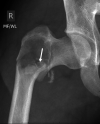Intramedullary Fixation With a Short Nail in a Young Patient Presenting With a Pathological Proximal Femur Fracture
- PMID: 34077396
- PMCID: PMC8174550
- DOI: 10.5435/JAAOSGlobal-D-21-00055
Intramedullary Fixation With a Short Nail in a Young Patient Presenting With a Pathological Proximal Femur Fracture
Abstract
An 18-year-old man presented with a pathological fracture of the right proximal femur. Desmoplastic fibroma was diagnosed through histological studies. Surgical management involved extended intralesional curettage and fracture stabilization by open reduction with intramedullary nailing, using a short Gamma nail. At 42-month follow-up, the patient presented no limitations or recurrence. Internal fixation after prior intralesional curettage is a valid treatment strategy for pathological fractures in young patients. A short nail was chosen to prevent direct tumor cell seeding throughout the femur and future recurrence. Fracture consolidation was achieved because of the healing potential of a young patient.
Copyright © 2021 The Authors. Published by Wolters Kluwer Health, Inc. on behalf of the American Academy of Orthopaedic Surgeons.
Figures






References
-
- Ishizaka T, Susa M, Sato C, et al. : Desmoplastic fibroma of bone arising in the cortex of the proximal femur. J Orthop Sci 2018;26:306-310. - PubMed
-
- Cho BH, Tye GW, Fuller CE, Rhodes JL: Desmoplastic fibroma of the pediatric cranium: Case report and review of the literature. Childs Nerv Syst 2013;29:2311-2315. - PubMed
-
- Takazawa K, Tsuchiya H, Yamamoto N, et al. : Osteosarcoma arising from desmoplastic fibroma treated 16 years earlier: A case report. J Orthop Sci 2003;8:864-868. - PubMed
Publication types
MeSH terms
LinkOut - more resources
Full Text Sources

